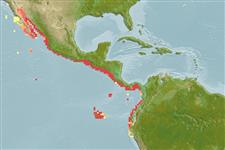>
Carangiformes (Jacks) >
Carangidae (Jacks and pompanos) > Caranginae
Etymology: Caranx: French, carangue, the name of a Caribbean fish; 1836 (Ref. 45335).
More on author: Günther.
Environment: milieu / climate zone / depth range / distribution range
Ecologia
marinhas; estuarina; oceanódromo (Ref. 51243); intervalo de profundidade 1 - 350 m (Ref. 9283). Subtropical; 33°N - 7°S, 119°W - 76°W
Eastern Pacific: San Diego, California, USA to Peru, including the Gulf of California and the Galapagos Islands. Probably the same species as Caranx hippos in the Atlantic.
Tamanho / Peso / Idade
Maturity: Lm ? range ? - ? cm
Max length : 101 cm FL macho/indeterminado; (Ref. 40637); common length : 60.0 cm TL macho/indeterminado; (Ref. 9283); peso máx. publicado: 17.7 kg (Ref. 40637); idade máx. registrada: 15 anos (Ref. 98594)
Body deep, elongated and slightly compressed; eye with an adipose eyelid; posterior edge of lower jaw behind posterior edge of eye; chest mostly scaleless, just a small patch in front of pectoral fins; 35 to 42 strong scutes; back of body blue to blue black; belly white, silvery, or yellow; pectoral fins and operculum each with a black spot (Ref. 55763).
Adults occur in oceanic and coastal waters, commonly found in shallow water, with larger individuals up to 350 m depth (Ref. 9283). Also found in brackish water and occasionally ascend rivers (Ref. 9283). They form medium-sized to big schools, but large adults may be solitary (Ref. 9283). They feed mainly on fishes, but also takes shrimps and other invertebrates (Ref. 9283). Often makes a grunting sound when captured (Ref. 9283). Juveniles are often found in river estuaries (Ref. 9283). Marketed fresh, frozen, smoked and salted or dried; also utilized as fishmeal and a source of oil (Ref. 9283).
Ciclo de vida ou comportamento de acasalamento
Maturidade | Reprodução | Desova | Ovos | Fecundidade | Larvas
Eschmeyer, W.N., E.S. Herald and H. Hammann, 1983. A field guide to Pacific coast fishes of North America. Boston (MA, USA): Houghton Mifflin Company. xii+336 p. (Ref. 2850)
Status na Lista Vermelha da UICN (Ref. 130435)
Ameaça para os humanos
Harmless
Uso pelos humanos
Warning: mysqli::__construct(): (HY000/1040): Too many connections in /var/www/html/includes/func_getlabel.php on line 46
Can't connect to MySQL database (fbapp). Errorcode: Too many connections
